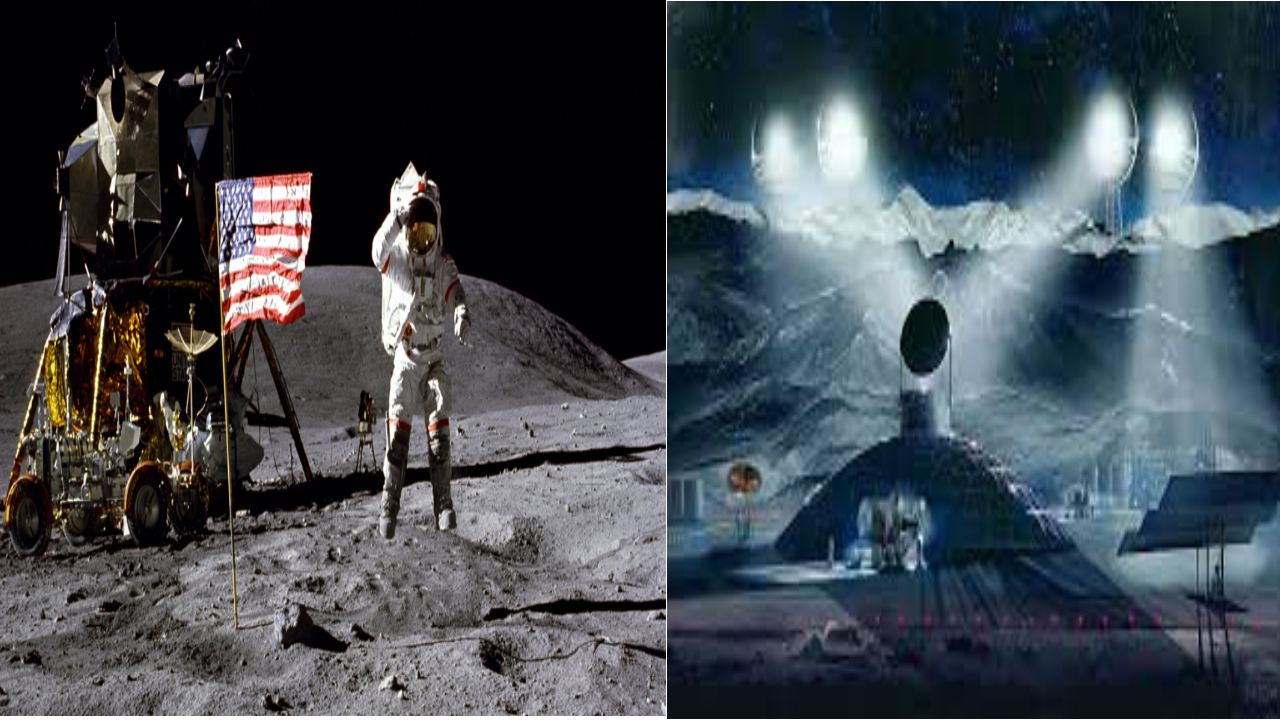A moon landing is the arrival of a spacecraft on the surface of the moon. Moon Landings include both manned and unmanned,i.e., robotic missions. The first human-made object to reach the surface of the moon was the Soviet Union’s Luna 2 mission on 13th September 1959
1. Escaping Earth: In order to go to the moon, a Spacecraft must first leave the “ Gravity Well “ of Earth. This requires it to attain “ Escape velocity “.The only practical way of accomplishing this is with a rocket. Other airborne vehicles such as balloons or jets lose thrust as they go higher due to the thing of the atmosphere. A rocket is the only known form of propulsion that can continue to increase its speed in the vacuum outside Earth’s atmosphere.
2. Landing on the Moon: Upon Approaching the moon, A spacecraft gets drawn ever closer to its surface at increasing speeds due to its gravity, In order to land intact, the spacecraft must decelerate to less than about 160 km per hour and toughened to withstand what is called a “ Hard Landing “ Impact. It may also decelerate to a negligible speed at contact for a “ soft landing “.A soft landing is the only viable option for human occupants. The Soviets first achieved the milestone of a hard lunar landing with a ruggedized camera in 1966. Only a month later, the US managed the first unmanned soft lunar landing.
3. Returning to Earth: To return to Earth, the escape velocity of the moon must be attained for the spacecraft to escape the gravity well of the moon. Again, rockets must be used to leave the moon and return to space. Upon reaching Earth, However, rockets are not needed for deceleration. Atmospheric entry techniques are used to absorb the kinetic energy of a returning spacecraft and thus reduce its speed for a safe landing.
Amazing Fun Fact: Armstrong maintains that he said,” One small step for men, One giant leap for mankind “, But the “a” was lost on the radio. One small step for man would mean the same thing as one small step for mankind.
4. Technical Difficulties: The return and landing functions greatly complicate a moon-landing mission. They lead to many additional, operational considerations.Some of these are noted in the sequence below
·1. Any Moon departure rocket must first be carried to the moon’s surface by a moon-landing rocket. This increases the latter’s required size.
· 2. The moon departure rocket, larger moon landing rocket, and any earth atmosphere entry equipment such as heat shields and parachutes must in turn be lifted by the original launch vehicle. This greatly increases the size of the original launch vehicle by a significant amount. In fact, it is this factor that makes moon missions expensive and difficult to an almost prohibitive degree.
5. Luna 2: Luna 2 of the E-14 Series was the second of the Soviet Union’s lune program spacecraft launched to the moon. It became the first spacecraft to reach the moon’s surface and the first artificial object to land on another celestial body. On 14th September 1959, Luna 2 Successfully landed east of Mare Imbrium near the craters Aristides, Archimedes, and Autolycus.
6. Luna 2 Construction: The instrumentation of Luna 2 was similar to Luna 1. It contained scintillation counters, Geiger counters, a magnetometer, Cherenkov detectors, and micrometeorite detectors. The luna 2 Had external boosters as there were no propulsion systems on it.
Apollo 11: Apollo 11 was the spaceflight that landed the first human on the moon. American Neil Armstrong and Buzz Aldrin landed on the surface of the moon on 20th July 1969, The third member of the mission, Astronaut Michael Collins, Piloted the command spacecraft alone in lunar orbit until Armstrong and Aldrin returned to it for the trip back to Earth.
Space Mining: Minerals could be mined from an asteroid or spent comet, then taken back to Earth or used in space for construction materials. This includes iron, nickel, and titanium for construction. The idea is important because Earth might run out of phosphorus, Antimony, zinc, tin, silver, lead, indium, gold, and copper in as little as 60 years.
Asteroids Used For Mining: Multiples types of asteroids have been identified as suitable for mining. The three main types include the C-Type, S-Type, and M-Type asteroids.
· C –Type Asteroids: C-Type asteroids have a high abundance of water. By using the available water from the asteroid rather than carrying it, We could reduce costs. C-Type asteroids also have a lot of organic carbon, Phosphorus, and other key ingredients for fertilizer; thus, they could be used to grow food.
· S-Type Asteroids: S-type Asteroids carry little water, but contain numerous metals that include nickel, cobalt, and more valuable metals such as gold, platinum, and rhodium. A small,10 m, S-Type asteroid is thought to contain about 650,000 kg of metal with kg of rare metals like platinum and gold.
· M –Type asteroids: M-Type Asteroids are very rare, But contain up to 10 times more metal than s-type asteroids.
Extraction Of Metal: Below is the process of extraction of Metal
· Surface Mining: On some types of asteroids, material may be scraped off the surface using a scoop. There is fairly strong evidence that many asteroids consist of rubble piles. This would make it possible.
· Shaft Mining: A mine can be dug into the asteroids and the materials extracted through the shaft. This would require precise knowledge about the accuracy of the Astro location under the surface regolith. We would also need a transportation system to carry the desired ore to the processing facility.
· Magnetic Rakes: Asteroids with a high metal contact may be covered in loose grains that can be simply scooped up using a magnet.
· Heating: For volatile materials in extinct comets, heat can be used to melt and vaporize the matrix and then extract the resulting vapor.
